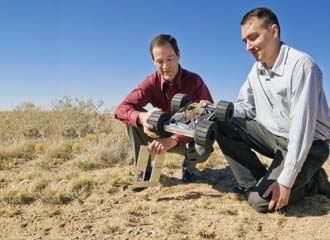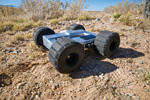Robot Looks and Leaps
 |
Sandia National Laboratories employees Jon Salton (l) and Steve Buerger put the Urban Hopper through its paces. |
A lightweight robot that can leap more than 20 feet horizontally and vertically could be fielded within a year if funding is made available. By enhancing situational awareness during urban combat operations, the robot has the potential to lower casualties both for civilians and for friendly forces fighting their way through a city environment.
During urban warfare missions, isolated squads engage in close-combat fights, often with high casualty rates and a massive drain on resources. In addition, conditions change rapidly, and maintaining situational awareness is a major challenge. Small robots increasingly play a critical role in city fighting, allowing small units to see over walls, into buildings or beyond any number of obstacles. They can be carried in a backpack, and some can be thrown over walls or on top of buildings. But many share a severe limitation—negotiating obstacles and finding their way back to the user once the mission is complete.
To solve that problem, the new robot, called the Urban Hopper, can leap straight up or straight out. It can hop over walls and back again, up and down stairways and over and beyond any number of obstacles found on city streets. And it can do it as many as 30 times. “It has the ability to drive like any other wheeled or tracked vehicle, but when it needs to negotiate an obstacle, whether it’s stairs or a wall or a platform it has to get over, it can hop over any of those obstacles,” says Jon Salton, distinguished member of the technical staff for Intelligent Systems, Robotics and Cybernetics at Sandia National Laboratories, Albuquerque, New Mexico.
Urban Hopper’s body tilts in different directions while negotiating tough terrain and in preparation for a jump. The tilting provides better aim capability and sets up the vehicle for either a shallow or steep leap. A small, combustion-driven, rotatable piston actuator enables the hopping capability. A commercial canister similar to those used to fire the ammunition in a paintball gun propels the vehicle upward and onward, Salton explains. He declines to give away the secret sauce inside the canisters but reveals that it is a mix of fuel and an oxidizer.
Salton says the vehicle is expected to provide enhanced situational awareness for special operations infantry squads or platoons. The vehicle also could be used for a wide variety of other missions, including local law enforcement, homeland security, search and rescue in challenging terrain and even planetary exploration.
Sandia developed the shoe-box-sized robot as a project sponsored by the Defense Advanced Research Projects Agency (DARPA). Urban Hopper passed the DARPA research and development phase, and in 2009 a contract was awarded to Boston Dynamics, Waltham, Massachusetts. Boston Dynamics has gained a lot of attention for its innovative systems, including BigDog, a quadruped built to maneuver tough terrain; RHex, a small, dog-like system capable of swimming, climbing and slogging through mud; RiSE, a wall-climbing wonder; Petman, a human-shaped robot designed to test equipment; and SquishBot, a chemical, shape-shifting system capable of squeezing through tight spaces. The engineering company began in 1992 as a spin-off from the Massachusetts Institute of Technology, developing robots that maneuver like animals.
For the most recent version of the Urban Hopper vehicle, Boston Dynamics better integrated the tilt actuator into the robot’s body, which means fewer moving parts, less weight and a more robust tilt capability. “Right now, the path forward for the vehicle is with the tilt-body configuration that Boston Dynamics has developed,” Salton says.
The vehicle carries a commercial off-the-shelf camera with an infrared capability. It also interfaces with commercial off-the-shelf technologies that map out unknown areas in two dimensions, and it has the ability to do 3-D imaging.
 |
The shoe-box-sized Urban Hopper robot is designed to navigate over rough terrain. |
In July, the vehicle successfully maneuvered through about a week of intensive formal testing with the National Institute of Standards and Technology. Testing included driving, hopping, navigation and communications. Sandia and Boston Dynamics currently are making the technology more robust and reliable so that the vehicle becomes more practical for users and could be more easily fielded. They recently completed the first phase of that process, and moving on to a second and final phase depends on finding more sponsors with money to invest.
“We’ve been developing this technology for years to get it to the point that industry can take it and mature it into something that can be fielded. That’s the infamous valley of death for technology. We’re still in the valley,” Salton concedes.
Salton’s team has approached the Department of Homeland Security, among others, but so far, there are no formal discussions with that department.
“We’re working hard to make sure there’s a way forward for the technology. We’re always looking for avenues to progress it and get it to the point that it’s more mainstream, more practical,” he says. “We don’t know if the current engagement will go into a second phase, so however long that dwell time lasts dictates whether we get to the other end. If we had funding today, we could get through that cycle in much less than a year. But, if I’m going to be an optimist and also be a realist, I’m going to say that in the next year we can get to that point.”
The team has faced a number of challenges, such as designing an appropriate shock management system for landings. The team also has managed to control hop height from varying terrain, including concrete, asphalt, sand and vegetation. Additionally, it has learned to control landings. “We really have overcome them all to the point that, I believe, this is now a viable, useful technology. We’ve shown its advantages. Now, with another iteration, we’ll make it fieldable and practical,” Salton says.
The Urban Hopper system is maturing at a time when budgets are being squeezed, so finding the funding to move it to the field may be the toughest challenge yet. “I’m a cheerleader for the technology and would like to see it go somewhere. Our dream job is when stuff actually gets fielded and gets used,” Stalton says.
Related Articles:
www.afcea.org/signal/articles/templates/Signal_Article_Template.asp?articleid=2376&zoneid=285
www.afcea.org/signal/articles/templates/Signal_Article_Template.asp?articleid=1779&zoneid=245
www.afcea.org/signal/articles/templates/SIGNAL_Article_Template.asp?articleid=1166&zoneid=40
WEB RESOURCES
Sandia National Laboratories: www.sandia.gov
Boston Dynamics: www.bostondynamics.com/bd_index.html
Urban Hopper Video: www.youtube.com/watch?v=fVirg8otLpQ




Comments